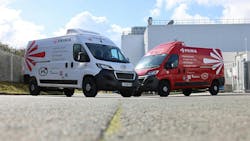Key takeaways:
- Phinia is moving from traditional fuel injection to alternative fuels like hydrogen and ethanol, emphasizing efficiency and decarbonization for captive fleets.
- Hydrogen offers potential but faces hurdles with material durability and the need for supportive infrastructure similar to Europe’s fueling stations.
- While electric vehicles are important for decarbonization, their growth has slowed, highlighting the need for diverse alternative fuel solutions alongside EVs.
After starting in traditional fuel injection systems, the company has branched into alternative fuels.
Many in the trucking industry have likely heard of Phinia. The company first began offering fuel injection systems, among other internal combustion engine staples, for vehicles ranging from passenger cars to heavy-duty commercial vehicles over a century ago.
But while they have more than a hundred years of traditional fuel systems, according to Todd Anderson, CTO at Phinia, the shift into cleaner, alternative fuels has been a far more recent one.
Alternative fuels include a whole host of substances, including hydrogen, ethanol, and even ammonia biofuels. Anderson views them as an “evolution” of the legacy systems, more focused on improving efficiencies.
Phinia also provides gasoline direct injection systems, which they began dabbling in roughly 15 years ago. Compared to traditional fuel injection systems, direct injection is considered more efficient due to the fuel “directly” entering the combustion chamber. Even more recently, the company began “looking into” hydrogen direct injection.
Phinia and the industry's hydrogen woes
For some, hydrogen is a bit taboo. Earlier this year, the high-profile bankruptcies of Nikola and Hyzon, both of whom relied on hydrogen as a fuel source, seemed to confirm fears that a “hydrogen highway” is too complicated a feat for now.
Anderson, however, sees it as more of a use-case issue. While he finds Nikola and Hyzon’s failures “concerning,” he believes success is possible when the “value proposition” is right, starting with captive fleets, which wouldn’t need to rely on public infrastructure being available for refueling.
“If there's a captive fleet that's domiciled and has vehicles that go out and back, one fuel station could accommodate that fleet. So, I think there's an opportunity for customers to really make strong progress on decarbonization,” he said.
Of course, availability was only part of the problem for the bankrupt companies. Phinia has run into its challenges in the clean technology sector, particularly in the shift from liquid to gas.
While diesel is injected in a liquid form, some alternative fuels as gaseous. According to Anderson, while there are similar principles involved, there’s more specific technology and other considerations needed for effectiveness.
“Hydrogen gas is very dry, and that dryness in the heat of a combustion engine can result in even high-alloy steel becoming hard,” Anderson said. “Over time, that can challenge the system’s durability. So, we've had to address that as a technical challenge, whether it's the right material selection or the timing of combustion so it doesn't happen prematurely.”
The challenges go beyond just technology: In a marketplace built for gasoline and diesel, how can Phinia implement alternative fuel systems? So far, leaders have turned to Europe for inspiration.
“There's an alternative fuels infrastructure requirement [in Europe] to have hydrogen fueling stations at every major city and every 200 km along the TEN-T network,” Anderson explained, before adding that there are also regulatory actions happening in to classify hydrogen as a zero-emission.
“But when you ask specifically, ‘Is that going to address things in the near-term?’ I think we've still got some time in front of us,” he said. “Let's say, five to 10 years before we start seeing broader adoption in higher volumes for hydrogen.”
But while interest in hydrogen offerings from the company has been the largest slice of the alternative fuel pie, it’s not the only one. Much of the demand, according to Anderson, is regionally based. In India, they get questions about flex fuel combustion as the country has a broad infrastructure for compressed natural gas.
Meanwhile in Brazil, the interest is geared towards ethanol. Much of Brazil’s natural resources, such as sugarcane, can be converted into ethanol, making it easier to move into E100 fuel systems.
See also: EPA to eliminate all greenhouse gas regulations
Phinia's stance on EVs
It’s hard to talk about alternative fuel of any kind without mentioning electric vehicles, which Anderson calls a “mega trend.” However, they haven’t quite exploded in popularity like many once thought.
“We see that in a lot of different places over the past 24 months or so, there's been a moderation in the EV messaging. A couple of years ago, you would think that electric vehicles were going to take over the world, and that's all there would be in the next 4 or 5 years,” Anderson noted.
While he, and as an extension Phinia, agree that EVs are part of a critical next step in decarbonizing transport, the use case is still severely limited in some ways.
“There's nothing wrong with electric vehicles […] there's absolutely a place where they're well suited and they do a very nice job, like passenger vehicles,” he said. “It's been growing and it will continue to grow, but maybe at a reduced pace or rate from what was initially projected as we look at some of the realities of a much larger electric vehicle fleet.”
The main issue is two-fold: Inadequate charging infrastructure and the relative “cleanliness” of using an electric vehicle. As Anderson put it, while your EV may not emit carbon itself, it still comes with a big footprint. In 2022, electric power production was the second largest emitter of greenhouse gases at 24%, just behind transportation’s 29%. Coal combustion was responsible for roughly 20% of electric power production. When you plug in to charge, it’s technically contributing to that.
For Phinia, which takes a ‘well to wheel’ perspective instead of wheel to tailpipe, it’s an “important consideration.”
“EVs are a trend, it'll continue, it's appropriate, but the trend is moderated some, and in it I think there is absolutely room for these other alternative fuels and other clean technology to work,” Anderson said. “Especially in applications like commercial vehicles where there's high loads and continuous operating cycles. I need a high payload and battery space can eat away at that. There's a need for each technology in the market segment where it's best suited.”
Phinia's focus on remanufacturing initiatives
The final piece in Phinia’s sustainability puzzle is its circular economy. Several Phinia products can be returned at the end of their “first life” and be remanufactured. However, the process doesn’t begin when the product returns to the facility; it starts in its initial design phases.
“The design locks in so much of that product life cycle that we must consider that early in the concept and design phase,” Anderson said.
To be clear, recycling is not the same as remanufacturing, and not all of Phinia’s products can be remanufactured. Polymers such as rubber, for example, become hard or break at the end of their life cycle, and can’t be reused. Instead, they are recycled to make more.
Remanufacturing, however, simply replaces parts that become worn out or used up. Phinia’s injectors are a major draw for the process. When a customer or dealership replaces the injectors on a vehicle, they can send the items back to Phinia for a credit, where they unscrew and remove specific internal components. Some of those components, Anderson said, are unusable.
“We put those aside, but everything else: the body and other elements of this injector, we can clean up. Then, we replace the worn components inside and put them back together. Now it's ready for a second life, but we didn't have to go through and remake the body and reuse steel for the cap nut because we're reusing those elements from the initial injector,” he said. “Now it's ready to go again with much less investment in materials and energy.”
About the Author

Jennifer Ramsay
Jennifer Ramsay is an editor-at-large at Endeavor Business Media. In her role, Ramsay is responsible for curating several of the Market Moves newsletters and keeping tabs on the latest in the world of electric vehicles and clean energy.
